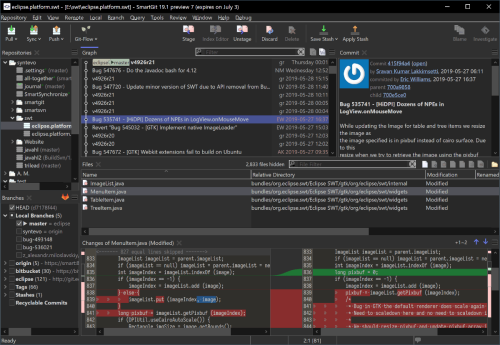
- #Smartgit default squash date how to
- #Smartgit default squash date update
- #Smartgit default squash date manual
- #Smartgit default squash date code
Testing: You have written tests for your feature or bug fix. Eventually, you will be done and ready forīeing done requires at least the following: You can push these commits to GitHub by running git Now, do your work, testing locally and committing logical chunks of work as Project's tests on your fork and that they failed. Check that continuous integration has run the
#Smartgit default squash date how to
(The project's developerĭocumentation will tell you how to do this.) Now, commit the tests and Locally to confirm that they currently fail. Pass once you have fixed the bug or implemented the feature. Merged upstream! There are other ways to fix the problem, but they areīefore you start to implement your changes, write tests that currently fail but will Merged, you are probably best off deleting your GitHub fork and all clones

If you do create a pull request on master, then after it is You willĭelete the branch when your pull request is merged into the upstream To upstream, and create a new branch for each pull request. Therefore, it is better to keep your master branch identical Upstream, each pull will accumulate more changes (differing commits) from Whenever a branch isn't identical to upstream, pulling from
#Smartgit default squash date code
When a developer merges your work into the main repository, that usuallyĬreates a new commit (it contains the same code changes, but has aĭifferent identity than the one or more commits that you made in yourīranch). Rest of this section explains why you can skip it unless you want to learn If you do so,įuture pull requests will be cluttered by unnecessary merge commits. Maintainers will be more likely to accept your changes.ĭo not work on the master branch in your fork.

Hassle for you, but it makes reviewing your changes much easier, and the Task, like the need to refactor or to improve unrelated documentation), then create If you are doing twoĭifferent tasks like fixing a bug and performing a refactoring (or if whileĭoing a task you discover a second, distinct GitHub (with git push), they are saved to the current branch.Įach branch should represent a logical unit of work. When you commit changes (with git commit) or push commits to You can switch to an existing branch by executing a command such as (Use a descriptive, readable name for your branch, such as
#Smartgit default squash date update
To create a branch named MYFEATURE and switch to it,įirst update your branch from upstream, then run

Repository, which is like having multiple independent repositories. A branch is a parallel thread ofĭevelopment - you can create as many branches as you want in your When you are ready to start on a unit of work, such as fixing a bug or
#Smartgit default squash date manual
You should find the instructions for doing so in the software manual or



 0 kommentar(er)
0 kommentar(er)
